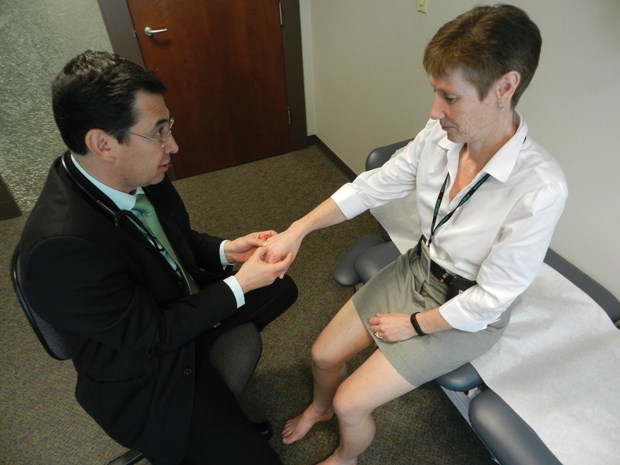"Our feet are already wet from the coming Tsunami," says Carolyn Jack, spokesperson for the Milan Illich Arthritis Research Centre, which set up shop last summer on No. 3 Road, across from Lansdowne Centre.
It's there, on the first few floors of the building housing Progressive Construction's headquarters, where leading scientists in Canada are attempting to form a beachhead against the disease which currently affects 4.6 million Canadians aged 15 and over.
That's a staggering one in six people who suffer with swollen, painful joints. And one that is in sharp focus in September, which is Arthritis Awareness Month in Canada.
But it's the prediction of where the debilitating disease is heading in the future that is even more alarming.
According to the Arthritis Research Centre of Canada, within a generation (by 2040), an estimated 10 million Canadians will be afflicted - a whopping one in four are expected to develop either osteoarthritis or rheumatoid arthritis, the two leading types of the disease.
So, you can see why there's an expected tidal wave of arthritis cases on the horizon.
But apart from the physical toll, there's a worrying, projected economic impact, as about 30 per cent of the national workforce will experience difficulty working because of arthritis.
The situation now is already estimated to cost the Canadian economy $33 billion in healthcare and productivity costs.
That's expected to double when the arthritis wave crests and crashes down on the affected population.
Some of the projected increases are fuelled by a glut of Baby Boomers, those born between 1946 and 1965, reaching their senior years. Statistics Canada's 2011 Census numbers estimate that includes 9.6 million people - or close to three out of 10 Canadians who fall into that generational category.
And that is anticipated to put even more strain on the already overburdened healthcare system.
So, will arthritis be the proverbial straw that breaks the camel's back? Not if Dr. John Esdaile, the centre's scientific director, and other researchers like him, can help it.
From the new surroundings in central Richmond, scientists are mapping out ways to battle the disease, hopefully turn the tide and take away its grip on the title as the most common cause of disability in the country.
A start in that direction is early diagnosis. Esdaile said a recent agreement with pharmacists at the Shoppers Drug Mart chain will allow initial screening for the disease to be done right in the store.
Plus, a smart phone and tablet-based app has also been developed that allows users to screen themselves for arthritis symptoms.
"Almost all the Shoppers Drug Mart pharmacies across the country are going to have available a pharmacist who will help the person through the app and review their medications for pain," Esdaile said.
"And eventually, within six weeks we will have the pharmacists actually being able to tell people if they have arthritis."
If caught early, as with many ailments, the chances of treating arthritis improves greatly.
And Esdaile said the centre has convinced arthritis doctors to see patients more readily - bringing down the wait from eight months to three weeks.
But it's not just drug therapy the centre is focusing on. In fact, Esdaile said the Richmond facility is not a basic science lab at all.
"We're not developing new drugs in test tubes. It's all very controlled and focused on people."
Part of that means working on aspects such as improved ergonomics to allow arthritis sufferers to operate better. "What the focus has been for the last 30 to 40 years has been waiting until people lose their job because their arthritis is so bad," Esdaile said.
One of the trials for back pain showed the most effective intervention was a simple improvement in ergonomics in the workplace, such as raising the platform they were standing on.
"It could be a better chair or an appropriate height for their computer," Esdaile said. "You can teach people things that can actually prevent them losing their jobs."
So, what is the prognosis for arthritis cases in the future? Can it be beaten, or at least is it likely there will be a significant drop in cases?
"I don't want to lie. I just don't know," Esdaile said. "But yes, if we succeed we will definitely see those numbers affected. I don't know if we are going to prevent rheumatoid arthritis from developing. Obviously, we'd like to. But let's not pretend.
"What we can do is eliminate the impact of the disease, so that we can have people who are functioning normally keep their jobs, and have a high quality of life. And there's no doubt we are doing that."
With more than 100 types of arthritis, Esdaile said, there is no "magic bullet" that will vanquish the disease.
What is more likely is a future where research into new drugs, therapies and ways of diagnosing the condition earlier that will result in limiting the impact the disease has on people.



